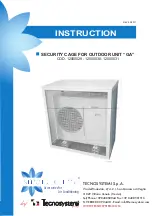
58
IM 738-2
Sequences of Operation:
Power-up
Sequences of Operation
The following sequences of operation are for a typical “C”
vintage applied rooftop unit equipped with MicroTech II, an
economizer, 4 compressor/4 stage cooling, 3 to 1 turn down
burner, variable frequency drives (VFD), a return air fan and
an external time clock. These sequences describe the ladder
wiring diagram logic in detail; refer to the wiring diagrams
legend on page 62 and Figures 75–87 on pages 65–87 as you
read them. Note that your unit’s sequences of operation may
vary from those described here. Refer to the wiring diagrams
supplied with the unit for exact information.
For detailed description of operation information relating to
the MicroTech II controller's software, refer to the appropriate
operation manual (see Table 1 on page 1). These manuals
describe the various setpoints, parameters, operating states,
and control algorithms that affect rooftop unit operation.
Power-up
When primary power is connected to the unit, 115VAC power
is fed through control circuit transformer T1 and control circuit
fuse F1C (line 168) to compressor crankcase heaters HTR-1,
HTR-2, HTR-3 and HTR-4 (lines 815, 848, 820, and 853).
When system switch S1 (line 203) is closed, low voltage
transformers T2 (line 203), T3 (line 301)and T9 (line 802)
energize, and 115VAC power is supplied to the following:
•
Smoke detectors (lines 265 and 267)
•
Economizer actuator ACT3 (line 313)
•
M30A to energize the supply fan VFD (line 426)
•
M40A to energize the return fan VFD (line 430)
•
Heating control panel (line 603)
•
Compressor circuit switches CS1 and CS2 (lines 805 and
838)
Transformer T2 supplies 24VAC power to terminals 24V and
COM on the main control board MCB (lines 207 and 208).
Transformer T2 supplies 24VAC power to the following:
•
Switch S7 On-Auto-Off (line 217)
•
Enthalpy sensor OAE (line 250)
•
External time clock contacts (line 215)
•
External exhaust fan status contacts (line 257, VAV only)
•
Airflow interlock switch PC7 (line 228)
•
Dirty filter switches PC5 and PC6 (lines 242 and 247)
•
Duct high limit switch DHL (line 260, VAV only)
•
Gas furnace alarm relay R24 (line 225)
•
Freezestat switch FS1 (line 231, hot water or steam heat
only)
•
Smoke detectors SD1 and SD2 (line 237)
When the field supplied Cool Enable switch is in the OFF
position, field wiring terminal TB2 105 de-energizes (line
220). Binary input MCB-BI3 de-energizes and the cooling is
disabled. When the field supplied Heat Enable switch is in the
OFF position, field wiring terminal TB2 106 de-energizes (line
223). Binary input MCB-BI4 de-energizes and the heating is
disabled.
Note:
Unit ships with factory installed jumpers between TB2
101 and 105 and between 101 and 106.
Fan Operation
When the main control board (MCB) commands the supply
and return fans to start, the unit enters the Startup operating
state. As a result, a 3-minute timer is set, output MCB-BO3
(line 307) energizes, and relay R26 energizes (line 306).
After the 3-minute timer expires, the unit enters the Recirc
operating state. As a result, output MCB-BO1 energizes relay
R67 (line 401). This gives a start signal to supply fan drive
AFD10 (line 445). Four seconds after MCB-BO1 is energized,
output MCB-BO2 energizes relay R68 (line 404). This gives a
start signal to return fan drive AFD20 (line 445).
Within 120 seconds after the fans start, the controller expects
airflow switch PC7 (line 228) to close and thus energize binary
input MCB-BI6. (If MCB-BI6 does not energize, the controller
assumes the fans did not start. It then shuts down the unit and
generates an alarm.)
During the Recirc operating state, the outside air damper is
held closed. The controller does this by energizing output
MCB-BO5 (line 318). On VAV units, output MCB-BO12, the
VAV box output, is also de-energized (line 309) during the
Recirc state.
The supply fan adjustable frequency drive (AFD10) is
modulated to maintain the duct static pressure setpoint. When
energized, output MCB-BO14 (line 407) drives AFD10 toward
increased capacity; MCB-BO13 (line 405) drives it toward
decreased capacity.On VAV units or CAV units equipped with
return fan capacity control, the adjustable frequency drive
(AFD20) is modulated to maintain an acceptable building static
pressure (using either VaneTrol logic or direct measurement of
building pressure; see the appropriate OM for more
information). When energized, output MCB-BO16 (line 409)
drives AFD20 toward increased capacity; MCB-BO15 (line
411) drives them toward decreased capacity.
Note:
If the inverter bypass switch S4 (lines426 and 430) is in
the bypass position, MMP30 and MMP40 (line 132 and
144) protect the fans from excessive current draw. If
either the supply or return fan is drawing excessive
current, one of the MMPs triggers an auxiliary contacts
(line 426) and open the circuit, causing both fans to
stop.
Summary of Contents for RDT-135c
Page 131: ...IM 738 2 129...
















































